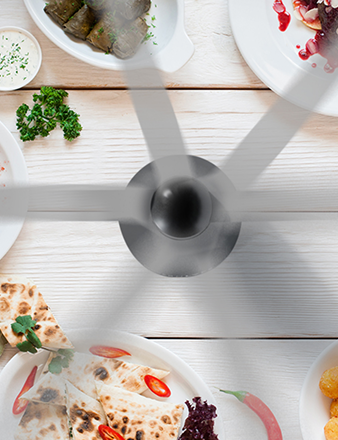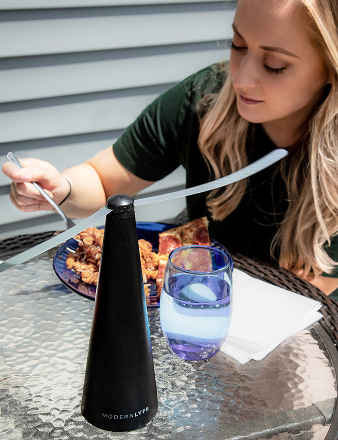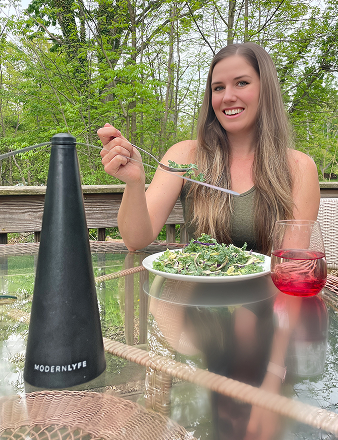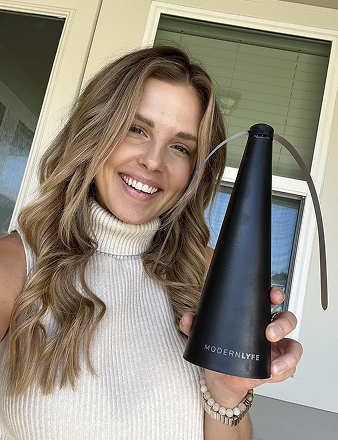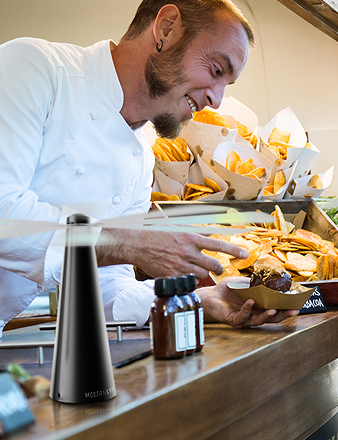The best way to get rid of fruit flies isn’t just setting traps—it’s a two-part strategy: aggressive sanitation and smart trapping. You have to break their lifecycle by eliminating their food and breeding spots while capturing the adults.
Where Did All These Fruit Flies Come From?
It feels like they appear from nowhere, right? One minute your kitchen is clean, the next you're swatting away a tiny cloud. That's not magic, it's biology on fast-forward. A single female fruit fly can lay up to 500 eggs in her short life, and those eggs become adults in about a week.
This is why a few flies can become a full-blown infestation overnight. They usually hitch a ride into your home on produce. That banana that's a little too ripe or the onion at the bottom of the pantry? That’s the perfect sugary, fermenting paradise they need to get started.
Why They Love Your Kitchen
While the fruit bowl is the obvious suspect, fruit flies are drawn to any fermenting organic matter. Finding these spots is critical, and you’d be surprised where they pop up.
Think beyond the obvious. These pests are resourceful and find hidden breeding spots you might not consider.
- Damp Sponges and Mops: A wet sponge in the sink or a damp mop head is a five-star hotel for fruit flies.
- Sticky Spills: That tiny bit of spilled juice, wine, or soda on the counter or floor is a banquet.
- Recycling Bins: The sticky residue in unrinsed soda cans and wine bottles is enough to support a family.
- Garbage Disposals and Drains: Tiny food particles stuck in your sink drain create an ideal, hidden nursery.
The secret to winning the war against fruit flies is to stop focusing only on the adults. You have to destroy their entire habitat. Remove their food and breeding grounds, and the population can't survive.
Before you set traps, a deep clean is your most powerful weapon. Here’s what to do the moment you see a fruit fly.
Your First Moves Against Fruit Flies
Take these critical first steps the moment you spot fruit flies to gain immediate control.
| Action Item | Why It Works | How Often |
|---|---|---|
| Empty All Trash Cans | Removes the primary food and breeding source. | Daily during an infestation |
| Wipe Down Counters | Cleans up sticky residues and crumbs. | Immediately after spills |
| Rinse Recycling Items | Eliminates sugary residue from cans and bottles. | Before placing in bin |
| Check for Old Produce | Finds and removes overripe or rotting fruit/veg. | At least twice a week |
Acting on these sanitation basics immediately disrupts the fruit fly lifecycle and makes any traps you set far more effective.
This problem is bigger than our kitchens. At a national level, these insects are a major threat to agriculture. The USDA's Fruit Fly Exclusion and Detection Programs maintain over 160,000 traps to monitor for them, a program that has prevented billions in economic losses since 1984. To go deeper, you can learn how the pros stop major outbreaks. It puts into perspective how persistent these pests are and why handling them in your home is so important.
Your Deep Clean Sanitation Playbook
To get rid of fruit flies for good, think like they do. They're not just looking for a meal; they’re hunting for the perfect decaying spot to lay hundreds of eggs. That's why a strategic deep clean is your most powerful weapon—it pulls the rug out from under them.
This isn't about just wiping counters. You need to get into the ignored nooks and crannies, because those are the damp, sticky havens where an infestation begins.
Target the Kitchen Hotspots
Your kitchen is ground zero. It’s a buffet of organic particles that create the ideal breeding environment. Let's hit the most common culprits you might be overlooking.
- Sink Drains & Garbage Disposals: Food particles washed down the sink create a film of gunk. Pour a half-cup of baking soda down the drain, followed by a cup of white vinegar. Let it fizz for about 10 minutes, then flush with very hot water.
- Trash Can Gunk: It's not enough to take out the bag. Scrub the can itself. The sticky residue from spills at the bottom is a major fruit fly magnet.
- Damp Sponges & Dishcloths: A soggy sponge, a sour dishcloth, or a mop head is a five-star fruit fly nursery. Wring them out thoroughly and let them dry completely between uses.
The infographic below breaks down how simple it is to locate and eliminate what keeps a fruit fly population going.

When you methodically remove their food, water, and breeding sites, you interrupt their lifecycle and shut down the infestation at its source.
Expanding the Search Beyond the Kitchen
While your kitchen is their headquarters, fruit flies are resourceful. They’ll set up shop in any area that offers moisture and fermenting organic matter. Don't stop your search at the kitchen door.
They breed in condensation trays behind refrigerators or in unrinsed recycling bins. A single forgotten orange at the bottom of a backpack can kickstart a huge problem.
Sanitation isn't a one-time fix; it's an ongoing defense. By taking away their breeding grounds, you make your home a place they can't survive. This is the foundation of any successful pest control plan.
Following comprehensive food safety sanitation guidelines is crucial for preventing future fly issues and keeping your home healthy.
Once you’ve scrubbed away their habitats, the remaining adult flies will be desperate for a new place to land, making them much easier to catch. For more tips, check out our guide on how to keep flies away from food. With sanitation complete, you're ready to trap the survivors.
Building a Better DIY Fruit Fly Trap
Now that you've scrubbed their breeding grounds, the remaining adult flies are on notice. They're homeless, hungry, and desperately seeking their next meal. This is your chance to lure them into a trap they can't escape. While store-bought traps exist, a homemade one gets the job done fast with things you already have.
The classic apple cider vinegar (ACV) trap is famous for a reason: it works. The fermented scent of ACV perfectly mimics the decaying fruit they love. But just pouring vinegar into a bowl isn't enough. A few simple tweaks make a huge difference.
The Classic Apple Cider Vinegar Trap, Perfected
Grab a small jar, bowl, or glass. Pour in about an inch of apple cider vinegar. Here's the key: you have to break the liquid's surface tension. Otherwise, flies can land on the vinegar, drink, and fly away.
A single drop of dish soap is all you need. The soap acts as a surfactant, so any fly that touches the liquid sinks and drowns almost instantly. This tiny addition turns a simple lure into a seriously effective trap.
Next, cover the container tightly with plastic wrap and secure it with a rubber band. Poke several small holes in the plastic with a toothpick. This design is what makes it so effective. The scent wafts out to draw them in, they crawl inside, and then they can't figure out how to get back out.
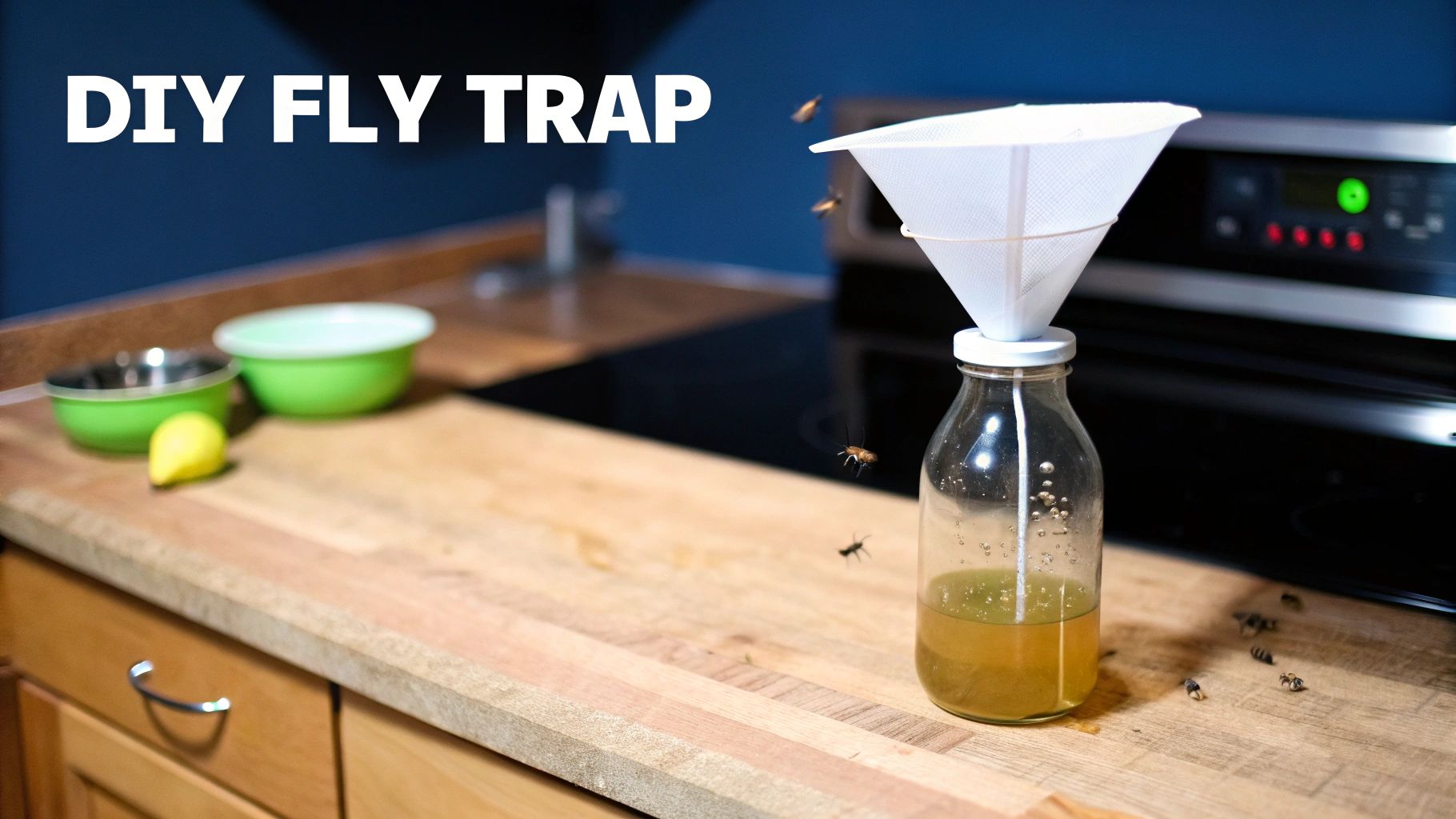
The goal of a DIY trap isn't just to attract flies, but to ensure they have no exit. The combination of a potent bait and a one-way entry is what makes these traps so effective.
Alternative Baits When Vinegar Isn't Enough
Sometimes, you'll encounter a stubborn swarm of flies that isn't tempted by ACV. When that happens, it’s time to get creative with other baits that tap into their love for sweet and fermented things.
- Red Wine: A splash of leftover red wine has a fruity, pungent aroma that's a magnet for fruit flies. Use it the same way as vinegar, with that crucial drop of soap.
- Overripe Fruit: This is my go-to when vinegar fails. A small piece of a mushy banana, peach, or melon in the jar can be more powerful than a liquid bait. Its natural fermentation is a signal they can't resist.
- A Touch of Yeast: To supercharge your trap, dissolve a pinch of active yeast with a teaspoon of sugar in a little warm water. As it ferments, it releases carbon dioxide—a major attractant for these pests. Get more ideas in our dedicated guide for a DIY fly trap for fruit flies.
Strategic Trap Placement for Maximum Impact
Where you put your traps is just as important as what's inside them. Think like a fruit fly. Where are they hanging out?
Place traps right next to the hotspots you just cleaned—by the sink, near the trash can, and close to your fruit bowl. If you've noticed them buzzing in one spot, put a trap right in their flight path. Setting up several small traps around the kitchen is much more effective than relying on one big one. You're creating a network of capture points the stragglers can't avoid.
Advanced Tools for Persistent Fly Problems
You’ve deep-cleaned, set out a dozen DIY traps, and yet… a stubborn cloud of fruit flies remains. It's incredibly frustrating. When you hit this point, it’s a sign you need to shift your strategy. A persistent infestation means moving beyond baiting and capturing to proactive defense.
This is when people reach for sticky traps or bug spray. They can work, but they have serious downsides. Sticky traps are gross, covered in dead flies for everyone to see. And using chemical sprays around your food prep areas is a definite concern, especially with kids or pets.
Introducing Air-Barrier Technology
A better approach is to use technology that creates a space where flies simply can't operate. This is the idea behind the Modern Lyfe fly fan. Instead of chemicals or sticky messes, these fans use gently spinning blades with special holographic tips to create a constant, soft air current.
This simple airflow is surprisingly effective in two ways:
- First, it physically disrupts their flight path. They're weak fliers, and the gentle breeze makes it impossible for them to land on your food or counters.
- Second, the reflective, holographic patterns on the blades confuse and disorient them, creating a protected, no-fly zone.
The result is an invisible barrier that works silently in the background, perfect for protecting a picnic spread or keeping your kitchen island clear while cooking. Learn more about how a fly repellent fan offers a completely chemical-free solution.
Long-Term Value and Safety
When you're thinking about how to get rid of fruit flies for good, consider the long-term investment. A can of spray or a pack of sticky traps is cheap now, but those costs add up. More importantly, they only deal with the problem after flies have already appeared.
A dedicated fly fan is a one-time purchase that provides continuous prevention. It shifts your strategy from reacting to a problem to proactively stopping it from starting. It’s clean, quiet, and a safe addition to any home.
This idea of using smarter, non-chemical pest control isn't just for homes. It’s used on a massive scale. For example, the Sterile Insect Technique (SIT) involves releasing sterilized male flies to prevent reproduction. This powerful, eco-friendly approach was used to wipe out a major fruit fly outbreak in the Dominican Republic in record time. Learning about this large-scale pest control method highlights how moving beyond traditional chemicals is the future.
A device like the Modern Lyfe fan brings that same forward-thinking, preventative mindset into your kitchen. It offers a reliable defense against fly problems without compromising on safety or aesthetics. It’s a smart choice for lasting peace of mind.
Creating a Permanently Fly-Free Home
Winning the battle against fruit flies is satisfying, but keeping them from coming back is the real goal. This is about shifting from reactive trapping to proactive prevention. Build a few simple habits into your routine, and you can make your home a place they simply can't stand.
The process begins the moment you bring groceries home. Fruit flies are notorious hitchhikers, often riding in on the produce you buy.
Before putting anything away, give your fruits and veggies a quick once-over. Look for any bruises, soft spots, or signs of overripening. Those are the exact places where female fruit flies lay their eggs.
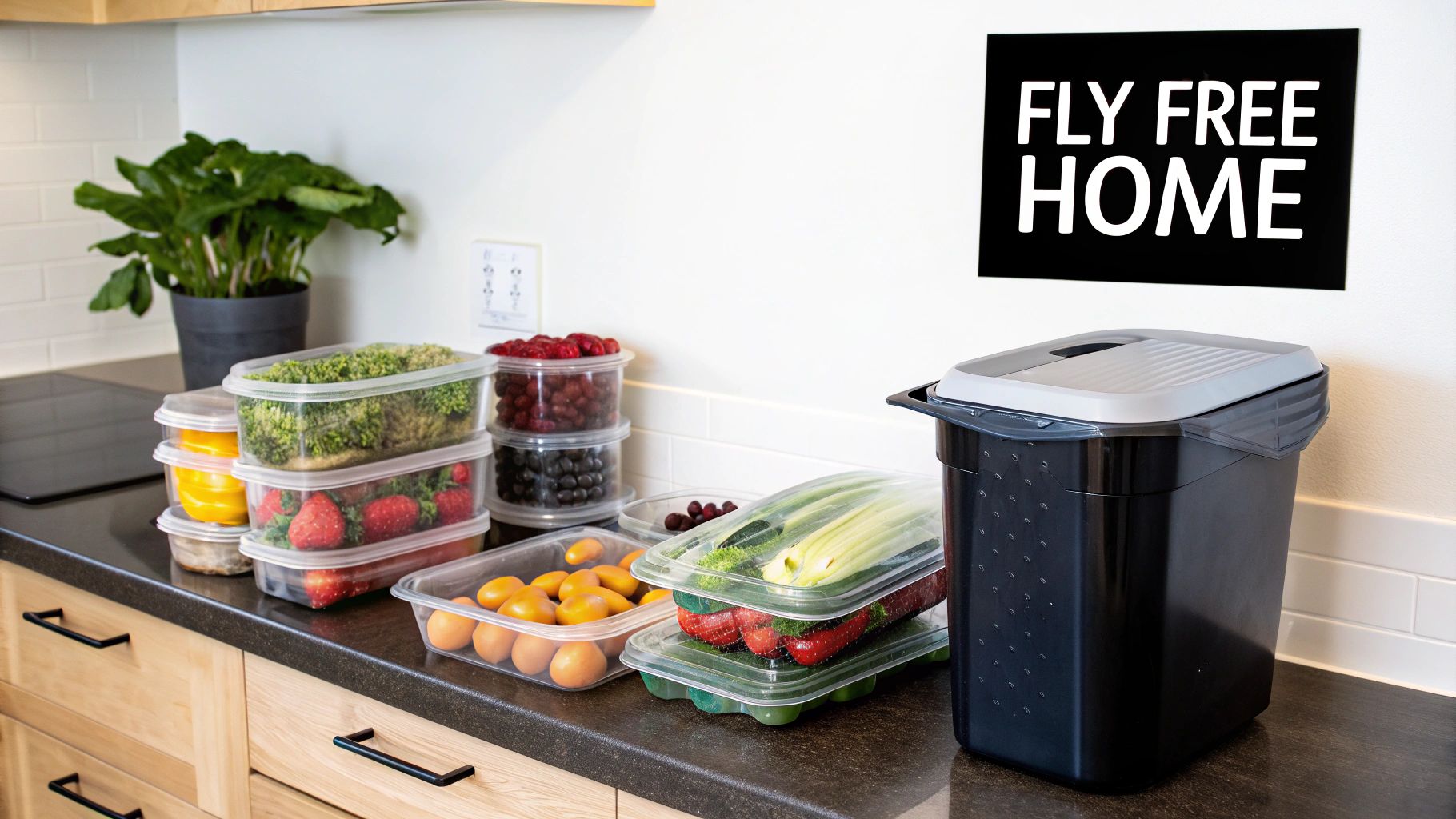
Smart Produce Storage and Waste Management
After inspection, your next line of defense is proper storage. You don't have to refrigerate everything, but knowing what to put away is crucial.
- Refrigerate Immediately: Berries and cut melons should go straight into the cold. If a piece of fruit is already looking too ripe, in it goes.
- Countertop with Caution: It’s fine to leave bananas, tomatoes, and potatoes out, but keep a close eye on them. The second they get too soft, use them or move them to the fridge.
- Airtight is Right: For pantry items like onions or potatoes, keep them in well-ventilated but secure containers. This stops potential larvae from escaping.
Managing your waste is just as important. A recycling bin with a little leftover soda or a compost pail that sits too long is a five-star resort for fruit flies. Always rinse recyclables and ensure your trash and compost bins have lids that seal tightly.
A proactive mindset is the ultimate key to a fly-free home. By treating your kitchen's entry and exit points—groceries coming in and waste going out—as critical control zones, you eliminate 90% of potential infestations before they start.
Maintaining Your Hidden Hotspots
Even with perfect habits, these pests can find other places to breed. Kitchen drains, for example, are infamous for collecting a slimy film of organic gunk that fruit flies find irresistible.
A simple weekly drain cleaning can make all the difference. For long-term prevention, it's all about good plumbing habits. There are great guides on how to keep your drains clear that offer solid, practical strategies.
Even a simple flush with hot water, followed by baking soda and vinegar, can break down that buildup. When you make these small routines part of your weekly cleanup, you’re creating a home that isn't just temporarily clean—it's permanently fly-free.
Frequently Asked Questions About Fruit Flies
Even with a solid plan, a few questions always pop up. Let's get them answered so you can feel confident you're on the right track.
How Long Does It Take to Get Rid of Fruit Flies?
If you're aggressive and thorough, you should see a huge drop in adult flies within 24 to 48 hours. That means eliminating their food sources and setting up good traps immediately.
But to completely break the cycle, give it about a week. This accounts for any sneaky eggs that might hatch after your initial clean-up. Consistency is key—if you let up, you give them a chance to rebound.
Do Fruit Flies Bite?
Thankfully, the answer is a firm no. Fruit flies don't have the mouthparts to bite people or pets. They're interested in the overripe banana on your counter, not you.
While they are incredibly annoying, you don't have to worry about them being a physical threat. The real concern is that they can carry bacteria from your garbage can to your fruit bowl.
Why Do They Keep Coming Back?
If you feel like you're stuck in a loop, it almost always points to a hidden breeding ground you've missed. You’ve scrubbed the counters and taken out the trash, but these pests are pros at finding tiny, forgotten spots to lay their eggs.
A persistent fruit fly problem isn't a sign of failure; it's a clue that a hidden food or moisture source is still out there. Think dirty drains, a rogue potato at the back of the pantry, or even a damp sponge under the sink.
Think like a detective. Expand your search beyond the obvious. Check under and behind appliances, look deep into cabinets, and don't forget places like bathroom trash cans where a wet tissue could be enough to start a new generation. Finding that one last source is how you win for good.
Can Fruit Flies Live in Drains?
Yes, and they absolutely love it in there. Drains are a five-star resort for fruit flies. The gunky, slimy buildup of organic material—sometimes called "biofilm"—is the perfect nursery for their eggs. It's dark, moist, and has a constant food supply.
This is why just setting out traps often isn't enough. You have to actively clean your drains. A simple routine with baking soda, vinegar, and a flush of hot water can destroy their hidden headquarters and is a critical step for keeping them gone for good.
Ready to upgrade your defense from reactive trapping to proactive prevention? The MODERN LYFE fly fan creates a permanent, chemical-free barrier that stops flies before they can ever land on your food. Discover the difference at modernlyfe.com.

